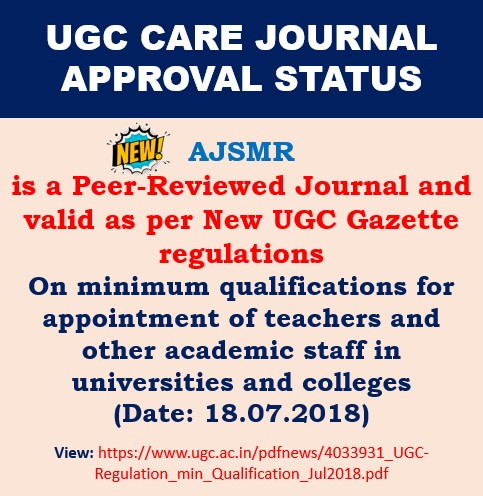Original Research Article I Volume 8 I Issue 1 I 2022
Physicochemical characteristics of industrial effluents collected from different industrial sites of India
Swetha Viddamuri, Gunaswetha Kuraganti, Sujatha Edla
The American Journal of Science and Medical Research; 8(1) Page 1-5
DOI:https://dx.doi.org/10.5281/zenodo.7178284
Abstract:
The need to control toxic materials from the effluents is currently increasing which may cause serious health problems like cancer and diseases. The present study was carried out to find the suitability of industrial effluents of different parts of India for irrigation purpose and to study the physicochemical characteristics. The samples of industrial discharge have been collected from various industries like pulp and paper mills from (Ballarsha, Maharashtra), paint industry (Bangalore), paper industry from (Sarapaka, Bhadrachalam), Diesel engine chemical soils (Warangal), card board (ookal). The collected effluent samples were preserved for further analysis to estimate the Physical Factors– Temperature, Colour, Turbidity, Odour; Chemical Factors – Alkalinity, pH, Total dissolved solids, Acidity; Organic Parameters – BOD, COD; and Inorganic Parameters –, Sulphates, Chlorides. In spite of using adequate treatment system, the industrial effluents were characterized by dark color, high levels of BOD, COD, TDS and significant concentration of phenols indicating significance of biological treatment system..
Keywords:
Warangal, Maharastra, Bangalore, Bhadrachalam, pH, COD, BOD
References:
[1] Ahmad, N., Ahmed, I., Shahzad, A., Khalid, N., Mehboob, F., Ahad, K., & Ali, G. M. (2014). Molecular identification and characterization of Pseudomonas sp. NCCP-407 for phenol degradation isolated from industrial waste. Journal of the Korean Society for Applied Biological Chemistry, 57(3), 341-346
[2] Akan, J. C., Moses, E. A., Ogugbuaja, V. O., &Abah, J. (2007). Assessment of tannery industrial effluents from Kano metropolis, Kano State, Nigeria. Journal of Applied Sciences, 7(19), 2788-2793
[3] Arutchelvan, V., Kanakasabai, V., Elangovan, R., Nagarajan, S., &Muralikrishnan, V. (2006). Kinetics of high strength phenol degradation using Bacillus brevis. Journal of hazardous materials, 129(1-3), 216-222
[4] Chandra, R., Raj, A., Yadav, S., & Patel, D. K. (2009). Reduction of pollutants in pulp paper mill effluent treated by PCP-degrading bacterial strains. Environmental monitoring and assessment, 155(1-4), 1.
[5] Ereqat, S. I., Abdelkader, A. A., Nasereddin, A. F., Al-Jawabreh, A. O., Zaid, T. M., Letnik, I., &Abdeen, Z. A. (2018). Isolation and characterization of phenol degrading bacterium strain Bacillus thuringiensis J20 from olive waste in Palestine. Journal of Environmental Science and Health, Part A, 53(1), 39-45
[6] Ghaly, A. E., Ananthashankar, R., Alhattab, M. V. V. R., &Ramakrishnan, V. V. (2014). Production, characterization and treatment of textile effluents: a critical review. J ChemEng Process Technol, 5(1), 1-19.
[7] Hamedo, H. A., El-Shamy, A. R., &Awad, H. M. (2015). Molecular Identification and Characterization of Phenol-Degrading Bacteria from Oil Contaminated Sea Water. J PURE APPL MICROBIO, 9(1), 71-7
[8] Hasan, S. A., &Jabeen, S. (2015). Degradation kinetics and pathway of phenol by Pseudomonas and Bacillus species. Biotechnology & Biotechnological Equipment, 29(1), 45-53.
[9] Hosetti, B. B., & Frost, S. (1994). Catalase activity in wastewater. Water Research, 28(2), 497-500.
[10] Imran, H. (2005). Wastewater monitoring of pharmaceutical industry: treatment and reuse options. Electron J Environ Agric Food Chem, 4(4), 994- 1004.
Article Dates:
Received: 12 December 2021; Accepted: 22 January 2022; Published: 10 February 2022
How To Cite:
https://dx.doi.org/10.5281/zenodo.7178284 Received: 12 December2021; Accepted: 22January 2022; Published: 10 February 2022



